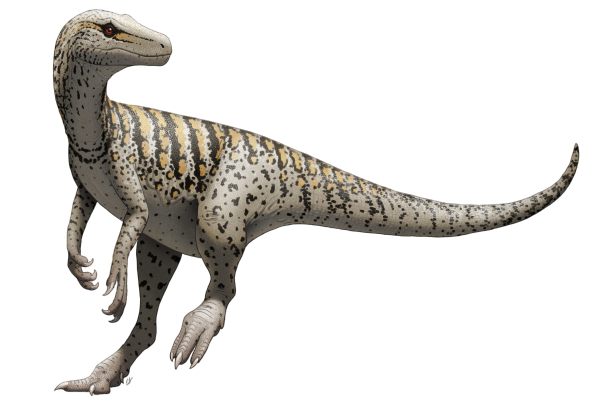Herrerasaurus is one of the early dinosaurs to have roamed our planet. The dinosaur genus first appeared in the Late Triassic period, and its fossils are considered vital to understanding the ecological and biological shifts at the dawn of the Mesozoic Era.

Discovery and Naming
Herrerasaurus’ story began hundreds of millions of years ago. But the paleontological research of this dinosaur starts in 1958 when Victorino Herrera, an Andean rancher, stumbled upon its remains in the stark landscape of Northwestern Argentina. Paleontologist Osvaldo Reig recognized the significance of Herrera’s find, leading to the genus’ christening as Herrerasaurus, meaning “Herrera’s lizard.”
The fossil trove, nestled within the layers of the Ischigualasto Formation, dates back to the Carnian stage of the Late Triassic, approximately 231.4 million years ago, setting the stage for a story that predates the reign of the dinosaurs.
What did Herrerasaurus look like?
Herrerasaurus was a creature built for the hunt. Its bipedal stance, boosted by strong hind limbs and longer feet, suggests a lifestyle of swift pursuit. Measuring up to 6 meters (20 feet) in length and weighing around 350 kg (770 pounds), it was not the largest predator of its time but it was fearsome.
The skull, up to 56 cm long (22 inches), housed a jaw filled with serrated teeth, hinting at a carnivorous diet. Perhaps its most intriguing feature was a flexible joint in the lower jaw, aiming for a grasping bite, a trait more commonly seen in certain lizards than in dinosaurs.
Is Herrerasaurus even a dinosaur?
Where Herrerasaurus fits within the dinosaur lineage was a controversial issue for paleontologists, primarily due to peculiarities in its hip. Its pelvic bones displayed a mix of both primitive and advanced features, complicating its placement within the traditional dinosaur taxonomy.
Its hip had a partially open hip socket and a pubis bone that pointed backward rather than forward. These features were not consistent with the then-known saurischian or ornithischian dinosaurs. This led to numerous debates about whether Herrerasaurus should be considered a dinosaur at all.
The resolution to these categorization challenges came with the understanding that Herrerasaurus depicted an early stage in dinosaur evolution. Its hip structure, rather than excluding it from the dinosaur clade, suggested that it was a basal form, with transitional features from archosaurs to dinosaurs.
This realization placed Herrerasaurus as an early saurischian, and one of the earliest members of the dinosaur lineage.

Herrerasaurus habitat
Herrerasaurus inhabited the Late Triassic landscape of what is now Argentina, a region within the immense supercontinent Pangaea. The climate was predominantly arid and dry, characterized by significant seasonal fluctuations. Temperatures were generally elevated due to the proximity to the equator. The terrain, marked by extensive deserts and sparse rivers, presented a challenging environment. During this time, Herrerasaurus coexisted with other early dinosaurs like the Eoraptor and the Pisanosaurus. Alongside these dinosaurs, it encountered diverse reptiles and the first mammals.
Paleobiological insights
The life of Herrerasaurus offers intriguing glimpses into the daily existence of one of the earliest dinosaurs. Studies of its scleral rings suggest a lifestyle of cathemeral activity, being active at intervals throughout the day. Remarkably, an examination of numerous Herrerasaurus bones revealed an absence of stress fractures, suggesting a life relatively free from the injuries commonly associated with predatory existence.
Herrerasaurus in Popular Culture
Despite its historical significance, Herrerasaurus is not as prominent in popular culture as its later dinosaur counterparts. Its presence in media is sparse, yet impactful when featured. It has made appearances in educational documentaries, highlighting its role in early dinosaur evolution. In interactive media, like video games, Herrerasaurus occasionally emerges, offering players a glimpse into the Triassic period. Museums also display fossils, educating the public about this early predator. While not a household name, Herrerasaurus is an icon amongst dinosaur enthusiasts.

Herrerasaurus, a pioneer of the Triassic landscape, offers a unique lens through which we can view the early days of the dinosaur era. Its discovery and subsequent studies have significantly advanced our understanding of dinosaur evolution, ecology, and behavior.






